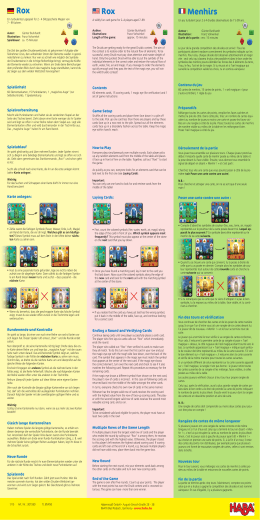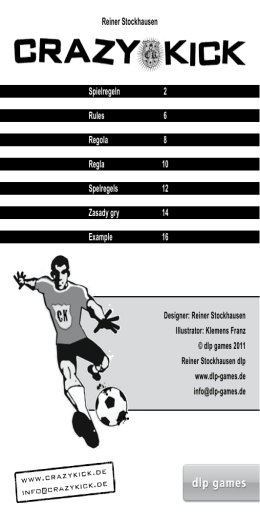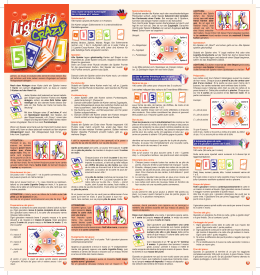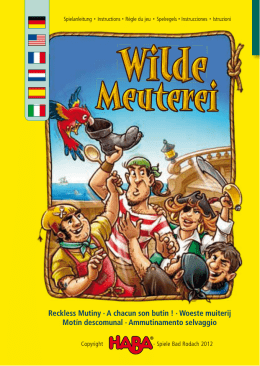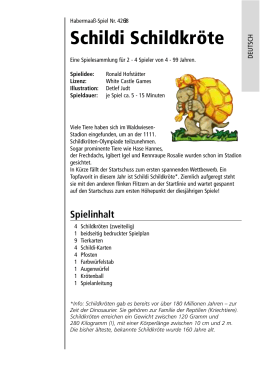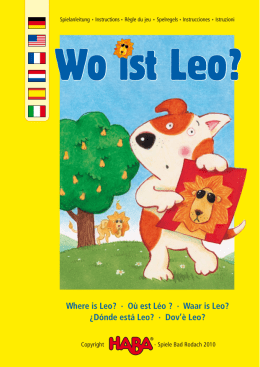Spielidee und Spielziel Die wilde Tango-Tarantel ist verzweifelt auf der Suche nach einem tierischen Tanzpartner. Die Tiere erschrecken jedoch beim bloßen Anblick der haarigen Giftspinne und schreien laut auf! Gewonnen hat, wer all seine Karten abgelegt hat. Autor: Illustration & Grafik: Redaktion: Jacques Zeimet Rolf Vogt Claudia Wieczorek Spieler(innen): Alter: Spieldauer: 2-5 ab 7 Jahren 15-20 Minuten Tango-Tarantel Tarantelkarten 2 Legt die Tango-Tarantel in die Tischmitte. Mischt alle 120 Karten gut durch und verteilt sie gleichmäßig an die Spieler. Anschließend nimmt jeder Spieler seine Karten als verdeckten Stapel in die Hand. Spielverlauf Material 115 Tierkarten (Hund, Kuh, • Esel, Ziege, Katze, Papagei) •5 Tarantelkarten •1 Tango-Tarantel (5-eckig) •Spielregel Spielvorbereitung Tierkarten Der jüngste Spieler beginnt und legt blitzschnell die oberste Karte seines Handstapels offen auf eines der fünf Felder (Seiten) an der TangoTarantel. Nun ist sein linker Nachbar an der Reihe. Abgelegt wird in Uhrzeigerrichtung. 3 Die verschiedenen Karten haben folgende Bedeutungen: Fehler 1) Tierkarte mit einer Tarantel Zeigt die Karte deines Vorgängers ein Tier mit einer Tarantel, ahme zuerst den Laut des abgebildeten Tiers nach und lege dann zügig die oberste Karte deines Handstapel ein Feld weiter ab. Tierlaute: Die Kuh macht „Muh“, der Esel „Iah“, die Ziege „Mäh“,der Hund „Wau“, die Katze „Miau“ und der Papagei ruft „Aua“. 2) Tierkarte mit zwei Taranteln Zeigt die Karte deines Vorgängers ein Tier mit zwei Taranteln, ahme zuerst zweimal den Laut des abgebildeten Tieres nach und lege dann zügig deine eigene Karte ein Feld weiter ab. 3) Tierkarte ohne Tarantel Zeigt die Vorgängerkarte ein Tier ohne Tarantel, lege deine eigene Karte ein Feld weiter ab, ohne einen Laut zu machen. 4 4) Doppeltierkarte ohne Tarantel Zeigt die Karte deines Vorgängers zwei Tiere, lege deine eigene Karte nicht ein Feld, sondern zwei Felder weiter ab ohne einen Laut zu machen. 5) Tarantelkarte Erscheint eine Tarantelkarte, schlagen alle Spieler mög- lichst schnell mit der flachen Hand vor sich auf den Tisch, um die Biester zu verjagen. Der langsamste Spieler muss alle ausliegenden Karten in seinen Handstapel aufnehmen. Jeder Spieler hat nur zwei Sekunden Zeit, um seinen Spielzug (gegebenenfalls einen Laut nachahmen und ablegen) korrekt auszuführen. Dabei darf er seine oberste Karte immer erst umdrehen und ablegen, nachdem er den Laut gemacht hat! Wer einen Fehler begeht, d.h. 1) wer zu lange zögert, stottert, einen falschen Laut (wie z.B. äh oder ööööhhhmmm) macht, 2) wer falsch, zu spät oder auch zu früh ruft oder ablegt, 3) wer falsch oder als Letzter auf den Tisch klatscht (Tarantelkarte), muss alle ausliegenden Karten aufnehmen und startet die neue Runde. Ende des Spiels und Sieger Wer zuerst keine Karten mehr auf der Hand hat, gewinnt das Spiel! 5 Beispiel: 1. Tina beginnt und legt eine Hundekarte mit Tarantel ab. 2. Ihr linker Nachbar Daniel ruft „Wau“ und spielt seine oberste Karte aus, diese zeigt eine Katze ohne Tarantel. 3. Bianca schweigt und legt eine Kuhkarte mit zwei Taranteln ab. 4. Anna macht „Muh Muh“ und spielt eine Tarantelkarte aus. 5. Alle schlagen mit der flachen Hand auf den Tisch. Daniel ist am langsamsten. Er nimmt alle ausliegenden Karten unter seinen Handstapel und startet eine neue Runde. Er legt eine Katze ohne Tarantel. 6. Bianca macht „Miau“ - das ist falsch, da auf der Vorgängerkarte ein Tier ohne Tarantel abgebildet ist. Sie nimmt die ausliegende Karte auf die Hand und beginnt eine neue Runde. Tarantel-Tipp: Spielt zunächst das Grundspiel. Beherrscht ihr dieses in einem flotten Tempo, könnt ihr durch Hinzunehmen der einzelnen Fortgeschrittenenregeln den Schwierigkeitsgrad erhöhen. (* =„leicht“ bis ****= „nur für Profis“) Regeln für Fortgeschrittene * Der störrische Esel bleibt stehen Zeigt die Vorgängerkarte einen Esel (mit/ohne Tarantel oder Doppelkarte), musst du deine eigene Karte nicht ein oder zwei Felder weiter, sondern auf das gleiche Feld, also auf den Esel, legen. (Natürlich mit oder ohne Laut.) 6 ** Der neugierige Hund läuft in die andere Richtung Wird ein Hund (mit/ohne Tarantel oder Doppelkarte) gespielt, wechselt die Ablegerichtung der Karten. Diese wird so lange beibehalten, bis der nächste Hund auftaucht. Dann kommt es erneut zu einem Richtungswechsel. Wird eine Hundekarte als erste Karte ausgespielt, muss die nächste Karte entgegen dem Uhrzeigersinn ausgelegt werden. *** Die blöde Kuh spielt noch einmal Wer eine Kuh (mit/ohne Tarantel oder Doppelkarte) ausspielt, ist gleich noch einmal an der Reihe, indem er muht bzw. schweigt. Dann legt er seine nächste Karte ein oder zwei Felder weiter ab. (Ist der nachfolgende Spieler zu hastig, muht oder legt er seine Karte zu früh ab, hat er einen Fehler begangen und muss alle ausliegenden Karten nehmen.) **** Der freche Papagei plappert alles nach Der Papagei ohne Tarantel imitiert den vorherigen Spieler. Der Doppelpapagei wiederholt demzufolge zwei Mal das Laut des vorherigen Spielers. Achtung: Bei den Papageikarten mit Tarantel ruft der Papagei weiterhin ganz normal „Aua“. 7 Idea and aim of the game The wild Tango Tarantula is desperately looking for one of the animals as a dancing partner! But the animals get scared and cry out every time the hairy and poisonous spider looks at them! The winner is the first contestant to get rid of all of their cards. Author: Jacques Zeimet Illustration & graphics:Rolf Vogt Editor: Claudia Wieczorek Players: Ages: Duration of game: Tango tarantula 2 to 5 7 years and over 15-20 minutes Tarantula cards 8 Place the Tango Tarantula in the middle of the table. Thoroughly shuffle all 120 cards and distribute them equally amongst the other players. The players then pick up their cards and hold their cards in the form of a pack so they can’t see their cards’ identity. How to play the basic game Contents 120 Animal cards (dog, cow, •donkey, goat, cat, parrot) 5 Tarantula cards • •Tango tarantula (5-sided) •Game rules How to prepare for the game Animal cards The youngest player starts and places the top card from their pack against one of the five sides of the Tango Tarantula. The player to their left now takes their turn. The cards are placed down in a clockwise direction. 9 The different cards have the following meanings: 1) Animal card with one tarantula If the card of the player who made their move before you displays an animal with one tarantula, you must first of all mimic the noise of the animal which is displayed, and then proceed to place the top card from your pack one space further along. Animal noises: The cow says ‘moo moo’, the donkey ‘eeyore’, the goat ‘maa’, the dog ‘woof’, the cat ‘meow’ and the parrot says ‘ow’. 2) Animal card with two tarantulas If the card of the player who made their move before you displays an animal with two tarantulas, you must first of all twice mimic the noise of the animal which is displayed, and then proceed to place your card one space further along. 3) Animal card without tarantula If the card of the player who made their move before you dis- plays an animal with no tarantula, place the top card from your pack one space further along without making a noise. 10 4) Double animal card without tarantula If the card of the player who made their move before you displays two animals, move your card not one, but two spaces further along without making a noise. 5) Tarantula card If a tarantula card appears then all players must slap the table with their hand as quickly as they can in order to fight the nasty beast off. The slowest player to hit the table has to pick up all the cards on the table and include them in their pack. Mistakes Each player has just two seconds to complete a move correctly (also including mimicking and animal noise and putting their card down). At the same time, the top card can only be turned over and placed after a noise has been made! Anyone who makes the following mistakes: 1) they take too long, hesitate, or make the wrong noise (like an ‘erm’ or a ‘baah’ for instance), 2) they make the wrong noise, they make it too late or too soon or they place their card down too late or too soon, 3) they slap the table too late or at the wrong time (Tarantula card) must pick up all the cards on the table and include them in their pack. End of the game and the winner The first person to get rid of all their cards wins the game! 11 Example: 1. Tina starts and plays her card, it’s a dog with one tarantula. 2. Her left hand neighbour Daniel calls out ‘woof’ and places his top card down which is a cat without a tarantula. 3. Bianca stays silent and places down her card, it’s a cow with two tarantulas. 4. Anna goes ‘moo moo’ and plays her card – it’s a tarantula card. 5. Everyone slaps the table. Daniel is slowest. He takes all the cards on the table, adds them to his pack and then starts a new round. He plays his card – it’s a cat without a tarantula. 6. Bianca goes ‘meow’, which is wrong because the last person’s card was of an animal without a tarantula. She picks up Daniel’s card and starts a new round. Tarantula tip: First of all, get used to playing the basic game. Once you’ve got your speed up, you can then increase the difficulty level by adopting the rules for experienced players (* = easy and **** = hardest). Rules for experienced players * The stubborn donkey won’t move If the card of the player who made their move before you is a donkey (with or without a tarantula or double card), then you don’t put your card one or two spaces further along, but on the same space – on top of the donkey, and, of course, with or without the appropriate noise. 12 ** The curious dog runs the wrong way If a dog (with or without a tarantula or double card) is played then the direction in which the players put down their cards changes. Everyone must stick to this rule until the next dog appears. The direction then changes once again. If a dog card is the first card to be played, the next card also has to be played in an anti clockwise direction. *** The dumb cow plays again Anyone who plays a cow (with or without a tarantula or double card) has to play another card straight away as soon as they have gone ‘moo’ or remained silent. They then have to place their next card one or two spaces further along. (If the next player is too fast, or moos or puts their card down too soon, they have made a mistake and have to pick up all the cards that are on the table). **** The cheeky parrot imitates everyone The parrot without a tarantula imitates the previous player. The double parrot repeats the noise of the previous player twice. Please note: with the parrot cards that have tarantula(s), the parrot shouts out ‘ow’ in the normal way. 13 Principe et but du jeu Tarentule Tango ne tient plus en place et cherche désespérément un animal pour danser avec elle. Mais tous prennent peur à la vue de l’araignée velue et venimeuse et poussent des cris terribles ! Le vainqueur sera le premier joueur à se débarrasser de toutes ses cartes. Auteur : Jacques Zeimet Illustrations & Graphisme : Rolf Vogt Rédaktion : Claudia Wieczorek Traduction: Eric Bouret Joueurs: Âge: Durée: Plaque Tarentule Tango 2à5 à partir de 7 ans 15 à 20 min Contenu 115 cartes Animal (chien, •vache, âne, chèvre, chat, perroquet) •5 cartes Tarentules 1 plaque Tarentule Tango •(pentagone) •cette règle 14 Cartes Animal Cartes Tarentules Préparation du jeu Placer la plaque Tarentule Tango au milieu de la table. Mélanger les 120 cartes et les distribuer équitablement à tous les joueurs. Chacun forme ensuite un paquet qu’il tient face cachée dans sa main. Déroulement du jeu Le plus jeune joueur commence et pose le plus vite possible la carte supérieure de son paquet sur l’une des 5 cases (côtés) autour de Tarentule Tango. C’est ensuite au tour de son voisin de gauche. Les cartes sont posées dans le sens des aiguilles d’une montre. 15 Signification de chaque type de carte : 1) Carte Animal avec une tarentule Si la carte du joueur précédent montre un animal avec une tarentule, le joueur suivant doit d’abord imiter le cri de l’animal représenté puis pose la carte supérieure de son paquet sur la case suivante. Cris des animaux : La vache crie « meuh », l’âne « hi-han », la chèvre « mêêê », le chien « ouaf », le chat « miaou » et le perroquet « aïe !». 5) Carte Tarentules Si la carte Tarentules apparaît, tous les joueurs frappent le plus rapidement possible la main à plat sur la table pour chasser ces bestioles. Le plus lent doit récupérer dans son paquet toutes les cartes déjà posées. Erreurs Chaque joueur ne dispose que de 2 secondes pour jouer correctement (voire imiter un cri et poser une carte). Il ne peut retourner et poser sa carte qu’une fois qu’il a (si nécessaire) poussé le cri ! S’il se trompe, c’està-dire : 2) Carte Animal avec deux tarentules Si la carte du joueur précédent montre un animal avec deux tarentules, le joueur suivant doit d’abord imiter deux fois le cri de l’animal représenté puis poser la carte supérieure de son paquet sur la case suivante. 3) Carte Animal sans tarentule Si la carte du joueur précédent montre un animal sans tarentule, le joueur suivant pose la carte supérieure de son paquet sur la case suivante sans pousser de cri. 3) s’il tape alors qu’il ne faut pas ou est le dernier à taper (carte Tarentules), 16 4) Carte Double animal sans tarentule Si la carte du joueur précédent montre un double animal sans tarentule, le joueur suivant pose la carte supérieure de son paquet deux cases plus loin sans pousser de cri. Fin de la partie et vainqueur 1) s’il hésite trop longtemps, bafouille, pousse le mauvais cri (par exemple êêh ou hummm), 2) s’il ne pose pas sa carte sur la bonne case, trop tôt ou trop tard, alors le joueur doit récupérer toutes les cartes jouées et il entame un nouveau tour. Le premier à s’être défaussé de toutes ses cartes remporte la partie. 17 Exemple: 1. Tina commence et place un chien avec une tarentule. 2. Son voisin de gauche crie « Ouaf » et joue la 1re carte de son paquet : un chat sans tarentule. 3. Bianca se tait et pose une vache avec deux tarentules. 4. Anna crie « meuh – meuh » et pose une carte Tarentules. 5. Tous frappent de la main sur la table. Daniel est le plus lent. Il récupère toutes les cartes jouées sous son paquet et entame un nouveau tour. Il pose un chat sans tarentule. 6. Bianca crie « miaou ». Erreur, car la carte précédente représente un animal sans tarentule ! Elle récupère la carte posée et entame un nouveau tour. Conseil : Commencer par le jeu de base. Une fois cette version bien maîtrisée à un rythme soutenu, il est possible d’ajouter les différentes règles avancées pour accroître le niveau de difficulté (de * = facile à **** = experts). Règles avancées * L’âne têtu refuse d’avancer Si la carte jouée précédemment montre un âne (avec ou sans tarentule ou double), le joueur suivant ne doit pas placer sa carte une case plus loin mais sur la même case, c’est-à-dire recouvrir l’âne (bien sûr, avec ou sans cri). 18 ** Le chien curieux part en sens contraire Si la carte jouée est un chien (avec ou sans tarentule ou double), le sens de pose des cartes change jusqu’à ce qu’un nouveau chien apparaisse. Le jeu revient alors en sens normal. Si la première carte jouée est un chien, la carte suivante doit être posée dans le sens inverse des aiguilles d’une montre autour de Tarentule Tango. *** La vache stupide rejoue Le joueur qui retourne une vache (avec ou sans tarentule ou double), rejoue une nouvelle fois sans oublier de crier ou de se taire. Il pose ensuite sa carte sur la case suivante. (Si le joueur suivant est trop pressé, s’il meugle ou pose sa carte trop tôt, il s’est trompé et doit récupérer toutes les cartes jouées.) **** L’insolent perroquet imite tout le monde Le perroquet sans tarentule imite le joueur précédent. Le double perroquet imite deux fois le cri du joueur précédent. Attention : le perroquet avec tarentule(s) continue de crier « aïe ! » normalement. 19 Spelidee en speldoel De wilde tango tarantula is wanhopig op zoek naar een danspartner. De dieren schrikken echter heel erg van dat harige en giftige beest, en schreeuwen het uit! Degene die als eerste al zijn kaarten afgelegd heeft, is de winnaar. Auteur: Jacques Zeimet Grafisme/illustraties: Rolf Vogt Uitgever: Claudia Wieczorek Aantal spelers: Leeftijd: Speelduur: Tango tarantulakaart Tarantula kaarten 2 tot 5 vanaf 7 jaar 15 – 20 minuten De jongste speler begint en legt bliksemsnel zijn bovenste kaart af aan één van de vijf hoeken van de tango tarantula. Nu is de linkerbuur aan de beurt. Er wordt in wijzerszin afgelegd. 115 dierenkaarten (hond, koe, •ezel, geit, kat, papegaai) •5 tarantula kaarten •1 Tango tarantulakaart (vijfhoekig) 20 Plaats de tango tarantula in het midden van de tafel. Schud de 120 kaarten goed door mekaar en verdeel ze gelijkmatig onder de spelers. Elke speler neemt dan zijn kaarten als een gedekte stapel in de hand. Spelverloop Inhoud •Spelregels Voorbereiding Dierenkaarten 21 De verschillende kaarten hebben volgende betekenis: 1) Dierenkaart met één tarantula Staat er op de kaart van je voorganger een dier met een tarantula, dan moet je eerst het geluid van dat dier nabootsen alvorens snel de bovenste kaart van jouw stapel af te leggen op het volgende veld. Dierengeluiden: de koe doet “boe”, de ezel “i-a”, de geit “mêê”, de hond “woef”, de kat “miauw”, en de papegaai roept “aua”. 2) Dierenkaart met twee tarantulas Indien er op de kaart van je voorganger twee tarantula’s afgebeeld staan, boots dan het geluid van het dier tweemaal na, en leg dan snel je bovenste kaart van je stapel af op het volgende veld. 3) Dierenkaart zonder tarantula Indien er op de kaart van je voorganger geen tarantula staat, leg je vliegensvlug je bovenste kaart af op het volgende veld, zonder een dierengeluid na te bootsen. 22 4) Dubbele dierenkaart zonder tarantula Beeldt de kaart van je voorganger twee dieren af, moet je jouw bovenste kaart niet één maar twee velden verder afleggen, zonder een geluid te maken. 5) Tarantula kaart Verschijnt er een tarantula kaart, dan slaan alle spelers om het snelst met de vlakke hand op tafel, om het beest te verjagen. De traagste speler moet alle reeds afgelegde kaarten in zijn handstapel opnemen. Fouten Elke speler krijgt slechts twee seconden om zijn beurt (een geluid imiteren indien nodig en een kaart afleggen) correct uit te voeren. Bovendien mag je jouw bovenste kaart pas omdraaien en afleggen na het dierengeluid. Indien je een fout maakt, t.t.z.: 1) je twijfelt te lang, je stottert, je maakt een fout geluid (zoals ah of euh), 2) je een fout dierengeluid zegt, te vroeg, of te laat, 3) je klopt op een fout moment op tafel, of als laatste, dan moet je alle afgelegde kaarten opnemen en een nieuwe ronde starten. Einde van het spel en winnaar Degene die geen kaarten meer in handen heeft, is de winnaar. 23 Voorbeeld: 1. Tina begint en legt een hondenkaart af met een tarantula. 2. Haar linkerbuur, Daniel, zegt “woef” en legt dan zijn bovenste kaart af, die een kat zonder tarantula afbeeldt. 3. Bianca zegt niets en legt een koekaart af met twee tarantula’s. 4. Anna zegt “boe boe” en speelt een tarantula kaart. 5. Iedereen klopt met de vlakke hand op tafel Daniel is de traagste. Hij stopt alle afgelegde kaarten onderaan zijn stapel en start een nieuwe ronde. Hij legt een kaart met een kat af, zonder tarantula. 6. Bianca zegt “miauw”. Dit mocht niet aangezien er geen tarantula op de kaart staat. Ze legt de afgelegde kaart onder haar stapel, en begint op haar beurt een nieuwe ronde. Tarantula tip: Speel eerst het basisspel. Beheers je dit in een vlot tempo, dan kan je de moeilijkheidsgraad wat gaan verhogen met de regels voor gevorderden (* = “gemakkelijk” tot **** = “enkel voor gevorderden”.) Regels voor gevorderden * De koppige ezel stopt Beeldt de kaart van je voorganger een ezel af (met of zonder tarantula, of dubbel dier), dan moet je jouw kaart niet één veld verder, maar op hetzelfde veld afleggen, in dit geval op de ezel. (Natuurlijk ook met of zonder dierengeluid). 24 ** De nieuwsgierige hond loopt in de andere richting Wordt de hond gespeeld (met of zonder tarantula, of dubbel dier), dan wisselt de aflegrichting. Dit wordt volgehouden totdat er opnieuw een hond opduikt. Dan wordt er opnieuw van richting veranderd. Indien een hondenkaart de eerste kaart is die wordt afgelegd, dan moet de volgende kaart tegen de richting van de wijzers afgelegd worden. *** De stomme koe speelt opnieuw Degene die een koe (met of zonder tarantula of dubbel dier) aflegt, is nog eens aan de beurt door te loeien of te zwijgen. Daarna legt hij zijn volgende kaart op het volgende veld af. (Indien de volgende speler te snel was, loeit of te snel een kaart aflegt, dan heeft hij een fout begaan en moet hij alle afgelegde kaarten nemen). **** De ondeugende papegaai zegt alles na De papegaai zonder tarantula imiteert de vorige speler. De dubbele papegaai herhaalt het geluid van de vorige speler tweemaal. Opgelet: bij een papegaaikaart met tarantula, blijft de papegaai “aua” zeggen. 25 Senso e scopo del gioco Quella matta della tarantola ballerina è alla disperata ricerca di un animale che le faccia da partner per il suo sfrenato tango. Gli animali, però, rabbrividiscono alla sola vista di quel ragno così velenoso e peloso e gridano per la paura!Vince chi per primo riesce a giocare tutte le sue carte. Autore: Jacques Zeimet Illustrazioni & Grafica: Rolf Vogt Redazione : Claudia Wieczorek Giocatori: Età: Durata del gioco: Tarantola ballerina Carte delle tarantole 2-5 dei 7 anni 15-20 min 115 carte degli animali (cane, •mucca, asino, capra. gatto e pappagallo) 26 Si pone la tarantola ballerina al centro del tavolo. Quindi si mescolano bene tutte e 120 le carte e le si distribuisce in numero uguale ai giocatori. Poi ogni giocatore prende in mano il mazzo coperto delle sue carte. Regole del gioco Contenuto •5 carte delle tarantole ballerina •(a15tarantola angoli) •Istruzioni del gioco Preparazione Carte degli animali Inizia il giocatore più giovane e scopre velocissimamente la carta più in alto del mazzo che tiene in mano, ponendola ad uno dei cinque angoli della tarantola ballerina. Ora è il turno del giocatore alla sua sinistra e il gioco procede così in senso orario. 27 Le carte hanno i seguenti significati: 1) Carta degli animali con una tarantola Se la carta del giocatore precedente mostra un animale con una tarantola, si deve innanzitutto imitare il verso dell’animale rappresentato e poi scoprire velocemente la carta più in alto nel proprio mazzo su una casella avanti. Versi degli animali: La mucca fa “muuh”, l’asino fa “hi-ho“, la capra “bee”, il cane “bau bau”, il gatto “miao” e il pappagallo urla “ahi!”. 2) Carta degli animali con due tarantole Se la carta del giocatore precedente mostra un animale con due tarantole, si deve innanzitutto imitare due volte il verso dell’animale rappresentato e poi scoprire velocemente la propria carta su una casella avanti. 3) Carta degli animali senza tarantole Se la carta del giocatore precedente mostra un animale senza tarantole, si deve scoprire la carta più in alto nel proprio mazzo su una casella avanti, senza fare alcun verso. 28 4) Carta con due animali e nessuna tarantola Se la carta del giocatore precedente mostra due animali, si deve scoprire la propria carta non una casella, bensì due caselle avanti, senza fare alcun verso. 5) Carta delle tarantole Se compare una carta delle tarantole, tutti i giocatori devo no battere la mano a palmo aperto sul tavolo il più velocemente possibile per schiacciare gli insetti. Il giocatore più lento deve prendere nel suo mazzo tutte le carte già scoperte. Errori In caso di errore, ogni giocatore ha due secondi di tempo per correggere la sua giocata (eventualmente imitare un verso e scoprire una carta). La carta più in alto nel proprio mazzo deve sempre essere girata e giocata solo dopo aver imitato il verso di un animale! Chi commette un errore, ossia 1) chi esita troppo a lungo, balbetta (facendo ad esempio eehh o mmmm) o imita il verso sbagliato, 2) chi scopre le carte o fa l’imitazione in modo sbagliato, troppo tardi o troppo presto, 3) chi batte la mano sul tavolo in modo sbagliato o da ultimo (in caso di carta delle tarantole), deve prendere nel suo mazzo tutte le carte già scoperte e iniziare il nuovo giro. Fine del gioco e vincitore Il giocatore che per primo esaurisce tutte le sue carte vince il gioco! 29 Esempio: 1. Tina inizia e scopre la carta del cane con una tarantola. 2. Il giocatore alla sua sinistra, Daniele, fa “bau bau” e gioca la carta più in alto nel suo mazzo, che mostra un gatto senza tarantole. 3. Bianca tace e scopre una carta della mucca con due tarantole. 4. Anna fa “muuh muuh” e gioca una carta delle tarantole. 5. Tutti battono la mano a palmo aperto sul tavolo. Daniele è il più lento a farlo. Prende allora nel suo mazzo tutte le carte già scoperte e inizia il nuovo giro. Scopre un gatto senza tarantole. 6. Bianca fa “miao”, sbagliando perché la carta del giocatore precedente mostrava un animale senza tarantole. Allora prende la carta giocata nel suo mazzo e inizia il nuovo giro. Suggerimento della tarantola: Si consiglia di giocare innanzitutto secondo le regole di base. Se riuscirete a familiarizzare con il gioco in breve tempo, è possibile aumentare il grado di difficoltà del gioco giocando secondo le regole per giocatori esperti. (da * =”facile” a ****= “solo per professionisti”). Variante per giocatori esperti * L’asino cocciuto non vuole muoversi Se la carta del giocatore precedente mostra un asino (con o senza tarantole o come animale doppio), il giocatore deve scoprire la sua carta non una casella avanti, bensì sulla stessa casella, ossia sull’asino stesso (facendo o non facendo il verso, come richiesto). 30 ** Il cane curioso corre nella direzione opposta Se viene giocato un cane (con o senza tarantole o come animale doppio), si inverte il senso in cui vengono scoperte le carte. Tale senso deve essere rispettato sino a quando non viene giocato un altro cane. Allora, il senso del gioco verrà nuovamente invertito. Se la carta del cane viene giocata come prima carta, la carta successiva deve essere scoperta in senso antiorario. *** La mucca sciocca gioca per due turni Chi gioca una mucca (con o senza tarantole o come animale doppio), gioca per due turni consecutivi, imitando il verso della mucca o tacendo come richiesto e scoprendo la sua carta successiva su una casella avanti. (Se il giocatore successivo è troppo frettoloso, muggisce o scopre troppo presto la sua carta, commette un errore e deve prendere tutte le carte già giocate). **** Il pappagallo impertinente ripete tutto quello che viene detto Il pappagallo senza tarantole imita il giocatore precedente. Il pappagallo doppio ripete dunque due volte il verso del giocatore precedente. Attenzione! Se viene giocata una carta del pappagallo con tarantole, il giocatore deve normalmente urlare “ahi!”. 31 Copyright 2009: DREI MAGIER SPIELE by Schmidt Spiele GmbH Postfach 470437 D-12313 Berlin www.dreimagier.de Art.-Nr. 40851 32
Scarica
